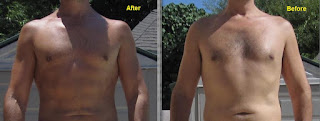The idea of gaining muscle and losing fat at the same time seems impossible because of three widely held misconceptions: (a) to gain muscle you need a calorie surplus; (b) to lose fat you need a calorie deficit; and (c) you cannot achieve a calorie surplus and deficit at the same time.
Not too long ago, unfortunately I was in the right position to do some self-experiments in order to try to gain muscle and concurrently lose fat, without steroids, keeping my weight essentially constant (within a range of a few lbs). This was because I was obese, and then reached a point in the fat loss stage where I could stop losing weight while attempting to lose fat. This is indeed difficult and slow, as muscle gain itself is slow, and it apparently becomes slower as one tries to restrict fat gain. Compounding that is the fact that self-experimentation invariably leads to some mistakes.
The photos below show how I looked toward the end of my transformation from obese to relatively lean (right), and then about 1.5 years after that (left). During this time I gained muscle and lost fat, in equal amounts. How do I know that? It is because my weight is the same in both photos, even though on the left my body fat percentage is approximately 5 points lower. I estimate it to be slightly over 12 percent (on the left). This translates into a difference of about 7.5 lbs, of “fat turning into muscle”, so to speak.
A previous post on my transformation from obese to relatively lean has more measurement details (). Interestingly, I am very close to being overweight, technically speaking, in both photos above! That is, in both photos I have a body mass index that is close to 25. In fact, after putting on even a small amount of muscle, like I did, it is very easy for someone to reach a body mass index of 25. See the table below, from the body mass index article on Wikipedia ().
As someone gains more muscle and remains lean, approaching his or her maximum natural muscular potential, that person will approach the limit between the overweight and obese areas on the figure above. This will happen even though the person may be fairly lean, say with a body fat percentage in the single digits for men and around 14-18 percent for women. This applies primarily to the 5’7’’ – 5’11’’ range; things get somewhat distorted toward the extremes.
Contrast this with true obesity, as in the photo below. This photo was taken when I was obese, at the beach. If I recall it properly, it was taken on the Atlantic City seashore, or a beach nearby. I was holding a bottle of regular soda, which is emblematic of the situation in which many people find themselves in today’s urban societies. It reminds me of a passage in Gary Taubes’s book “Good Calories, Bad Calories” (), where someone who had recently discovered the deliciousness of water sweetened with sugar wondered why anyone “of means” would drink plain water ever again.
Now, you may rightfully say that a body composition change of about 7.5 lbs in 1.5 years is pitiful. Indeed, there are some people, typically young men, who will achieve this in a few months without steroids. But they are relatively rare; Scooby has a good summary of muscle gain expectations (). As for me, I am almost 50 years old, an age where muscle gain is not supposed to happen at all. I tend to gain fat very easily, but not muscle. And I was obese not too long ago. My results should be at the very low end of the scale of accomplishment for most people doing the right things.
By the way, the idea that muscle gain cannot happen after 40 years of age or so is another misconception; even though aging seems to promote muscle loss and fat gain, in part due to natural hormonal changes. There is evidence that many men may experience of low point (i.e., a trough) in their growth hormone and testosterone levels in their mid-40s, possibly due to a combination of modern diet and lifestyle factors. Still, many men in their 50s and 60s have higher levels ().
And what are the right things to do if one wants to gain muscle and lose fat at the same time? In my next post I will discuss the misconceptions mentioned at the beginning of this post, and a simple approach for concurrently gaining muscle and losing fat. The discussion will be based on my own experience and that of several HCE () users. The approach relies heavily on individual customization; so it will probably be easier to understand than to implement. Strength training is part of this simple strategy.
One puzzling aspect of strength training, from an evolutionary perspective, is that people tend to be able to do a lot more of it than is optimal for them. And, when they do even a bit more than they should, muscle gain stalls or even regresses. The minimalists frequently have the best results.


